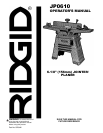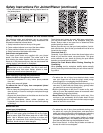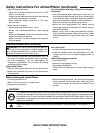
7
Glossary of Terms for Woodworking
Bed
The combination of infeed and outfeed table surfaces
which support the workpiece during a cutting operation.
Bevel/Chamfer
Removing wood along the edge of a board to make that
edge straight, smooth and angled to the board face which
is against the fence.
Cutter Guard
Spring loaded guard or shield covering the cutter head.
Cutter Head
The cutter head is a rotating piece with three adjustable
knives. The cutter head removes material from the work-
piece
Depth of cut
A term used to indicate how deep into the workpiece the
cutter knives will cut.
Fence
The fence is attached to the jointer/planer base. The
fence helps support and guide the workpiece as it is
pushed across the cutter head.
Freehand
Using the tool without holding the workpiece firmly
against the fence and
table. This can let the workpiece
twist and kick back and must never be attempted.
Gum
A sticky, sap based residue from wood products.
Hold-Down/Push-Blocks
They are required for your own safety. They are used to
hold your workpieces against the table and
fence when
planing, rabbeting or jointing.
Infeed Table
The section of the jointer bed upon which the workpiece
is placed before being pushed into the cutter head.
Infeed table height is adjustable which allows the opera-
tor to select the depth of cut.
Jointing
The removal of wood along the edge of a board so as to
make that edge straight, smooth and square to the board
face which is against the fence.
Kickback
An uncontrolled grabbing and throwing of the workpiece
back toward the operator by the rotating cutter head.
Leading End
The end of the workpiece which is pushed into the cutter
head first.
Outfeed Table
The section of a jointer bed which supports the workpiece
after it passes over the cutter head.
Planing
Removing wood from the widest surface or face of a
board so as to make it flat and smooth.
Rabbet
A notch cut into the edge of workpiece.
Resin
A sticky, sap based substance that has hardened.
Revolutions Per Minute (RPM)
The number of turns completed by a spinning object in
one minute.
Throw-Back
Throwing of pieces in a manner similar to a kickback.
Trailing End
The workpiece end last cut by the knives.
Workpiece
The item on which the cutting operation is being per-
formed. The surfaces of a workpiece are commonly
referred to as faces, ends and edges.
Motor Specifications and Electrical Requirements
Power Supply and Motor Specifications
WARNING: To reduce the risk of electrical hazards,
fire hazards or damage to the tool, use proper circuit
protection. Your tool is wired at the factory for opera-
tion using the voltage shown. Connect tool to a power
line with the appropriate voltage and a 15-amp branch
circuit. Use a 15-amp time delay type fuse or circuit
breaker. To reduce the risk of shock or fire, if power
cord is worn or cut, or damaged in any way, have it
replaced immediately.
The A/C motor used on this tool is a capacitor start, non-
reversible type, wired at the factory for 110-120V AC, 60 Hz.
operation. Follow the instructions on page 8 to connect the
motor for 220-240V A/C operation.
Face
Edge
End
Rabbet
Rated Horsepower 1
Voltage
110-120 220-240
Amperes
12 6
Hertz (Cycles)
60
Phase
Single
RPM
3450
Rotation of Shaft
Counterclockwise


















